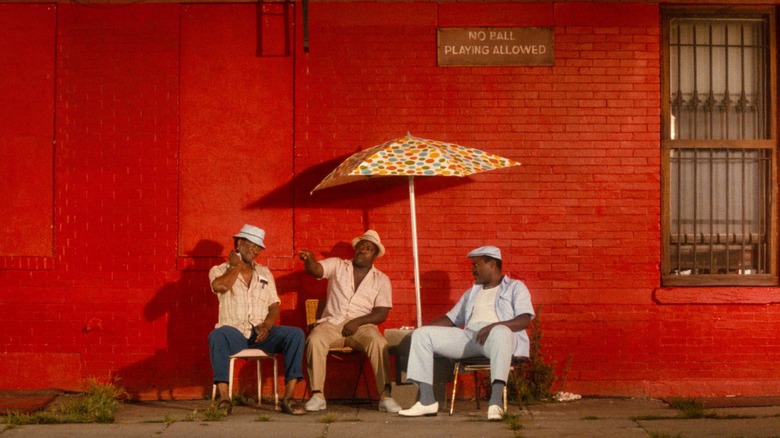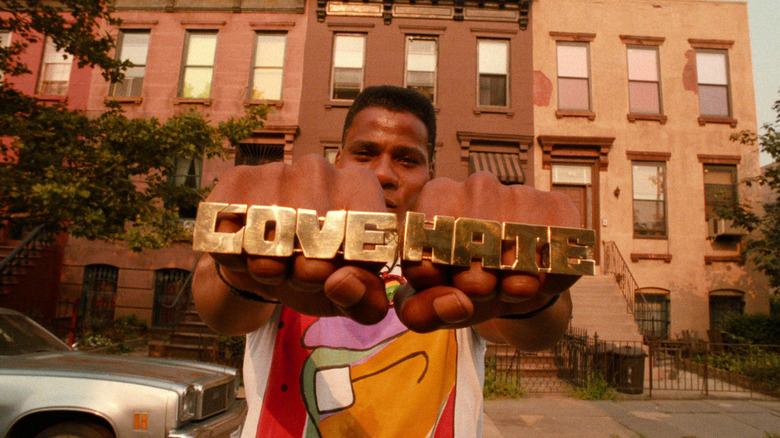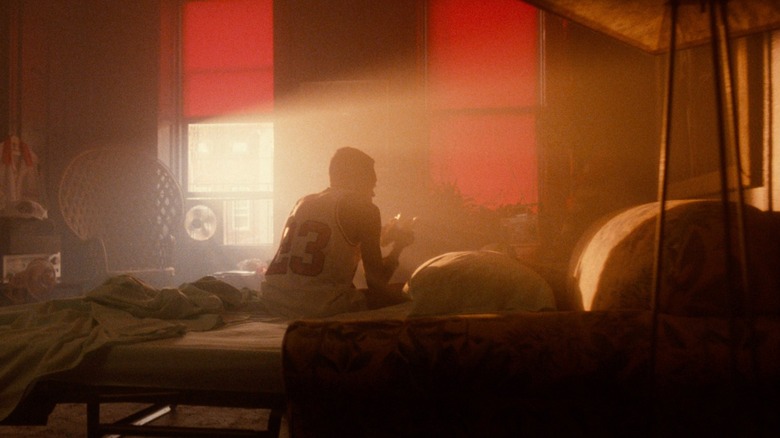Spike Lee Wanted To Send A Message With Do The Right Thing's Set Design
Following an impressive freshman debut and sophomore follow-up, "Do The Right Thing" served as Spike Lee's audacious arrival as an influential filmmaker in the movie industry. After exploring the issue of control in "She's Gotta Have It" with a micro-budget of less than $200,000, Lee creatively examined divisions within the Black community with the musical comedy "School Daze."
By the time he produced his third film, Lee had established his own production company in the heart of Brooklyn. It was in Brooklyn's Bedford-Stuyvesant neighborhood where he unapologetically scrutinized racial strife in a tumultuous 1980s New York City. "Do The Right Thing" is one of the most important films ever made about race in America.
It does not give racism the effervescent Hollywood treatment, instead asking audiences to observe and question for themselves what is right and wrong. At the end of the film, lessons aren't learned, the narrative simply rinses and repeats. It's not a critique but rather a sad reflection of race in America.
To pull it off, the emerging young filmmaker used set design and mise-en-scène to send a message about the authenticity and circumstances of the people in Bed-Stuy.
Shooting on location in Bed-Stuy
The Brooklyn, New York neighborhood known as Bedford-Stuyvesant (or Bed-Stuy), used to have a bit of a reputation. Billy Joel sang about it as a dangerous place in the modern pop culture zeitgeist ("I walked through Bedford Stuy alone"). The 650-block neighborhood was once predominantly Black and known for its poverty and crime. "Things are getting worse, and the only people who stay are the ones who can't afford to go nowhere else," one resident described their immobility in the early 1980s.
In 1989, following a decade of racial tension in New York City, up-and-coming New York filmmaker Spike Lee decided to tell New York's story, with Bed-Stuy as the backdrop. But he didn't want the location to take away from the film's message. He used set design to present a sanitized version of the neighborhood. They cleaned up three blocks of the neighborhood for the film shoot. In 1989, Lee told Film Comment:
"I made that choice because any time you hear people say Bed-Stuy, right away they think of the rapes, murders, drugs. There's no need to show garbage piled up high and all that other stuff, because not every single block in Bed-Stuy is like that."
Lee also wanted "Do The Right Thing" to have a singular focus. "Another thing people ask, 'Where are the drugs?' Drugs are such a massive subject, it just can't be dealt with effectively as a subplot," Lee explained in filmmaking terms. "You have to do an entire film on drugs. This film was not about that. This film was about racism."
Beyond set design, Lee brilliantly used mise en scène to manifest the oppression felt by Bed-Stuy residents onto the screen.
You can literally see the heat
The look and feel of "Do The Right Thing" tell us that under the white-hot spotlight of oppression, it only takes a tiny spark to light an entire neighborhood on fire. In the film, the temperature rises above 100 degrees in a neighborhood where most people lack any type of respite from the heat. The fire is eventually lit when police kill a young Black man while responding to a neighborhood disturbance.
Spike Lee captured the temperature in Bed-Stuy by using a color palette of deep reds, yellows, and browns, reflecting the unrelenting heat felt by the characters. Hazy indoor lighting represents humidity that hangs over the neighborhood in a stifling fashion.
Lee and cinematographer Ernest Dickerson used canted angles and close-ups to emphasize the uncomfortable emotions and claustrophobia felt by the characters. They also placed Sterno fuel cans in front of the camera to make the heat literally waft up in front of the lens. If it seems like you can see the heat while watching the movie, that's because it was there.
Lee's decision to emphasize the people of Bed-Stuy rather than the location sets "Do The Right Thing" apart from Hollywood's typical depictions of poverty. Lee said:
"It would be a fallacy to say that lower-income people always live in burned-out buildings. These are hard-working people, and they take pride in their stuff just like everybody else. So there's no need for the set to look like Charlotte Street in the South Bronx."
By making Bedford-Stuyvesant look nothing like it actually did in 1989, Lee still accurately captured the essence of the neighborhood, both the love and the hate, that permeated through the uncompromising 1989 New York heat.


